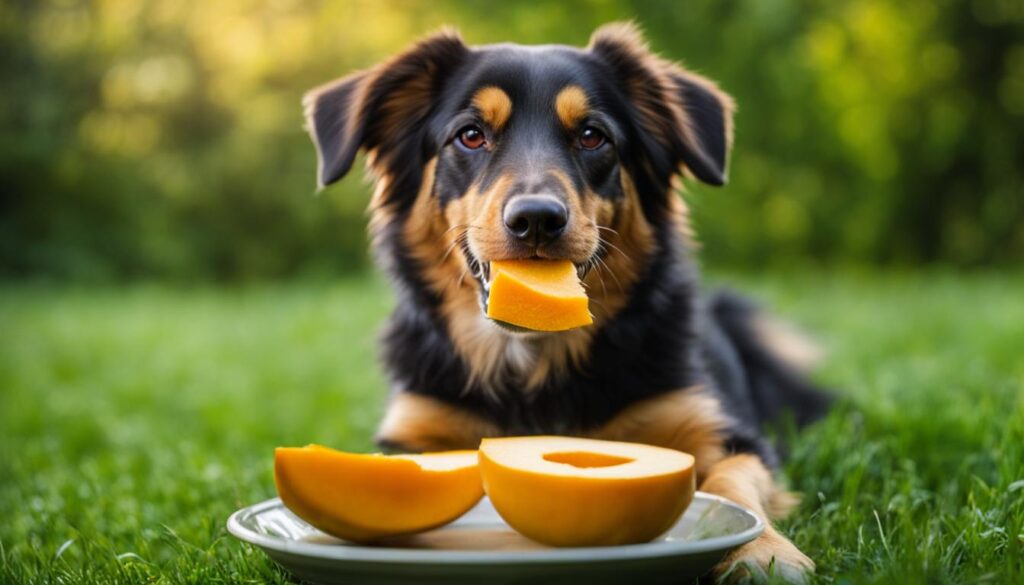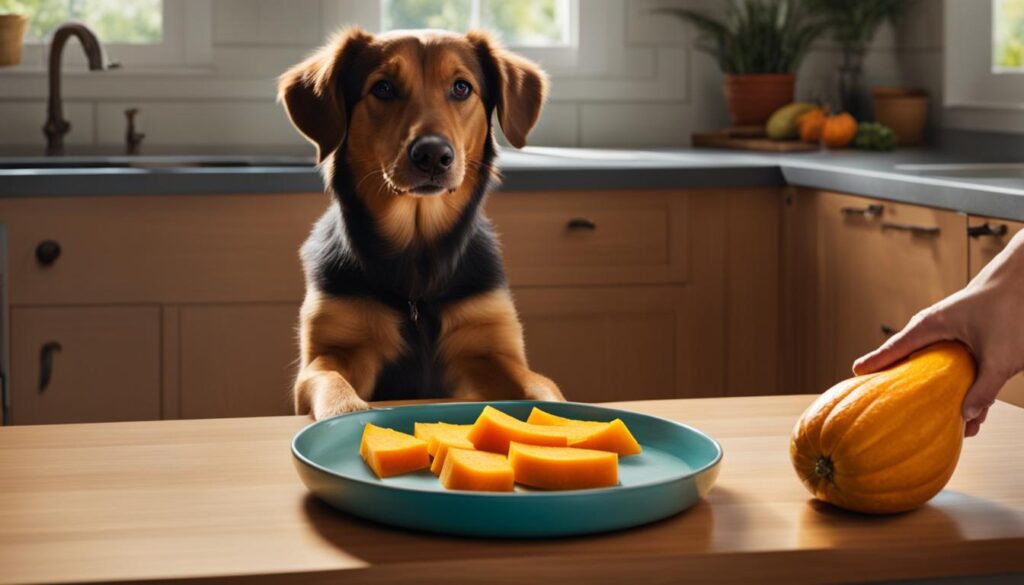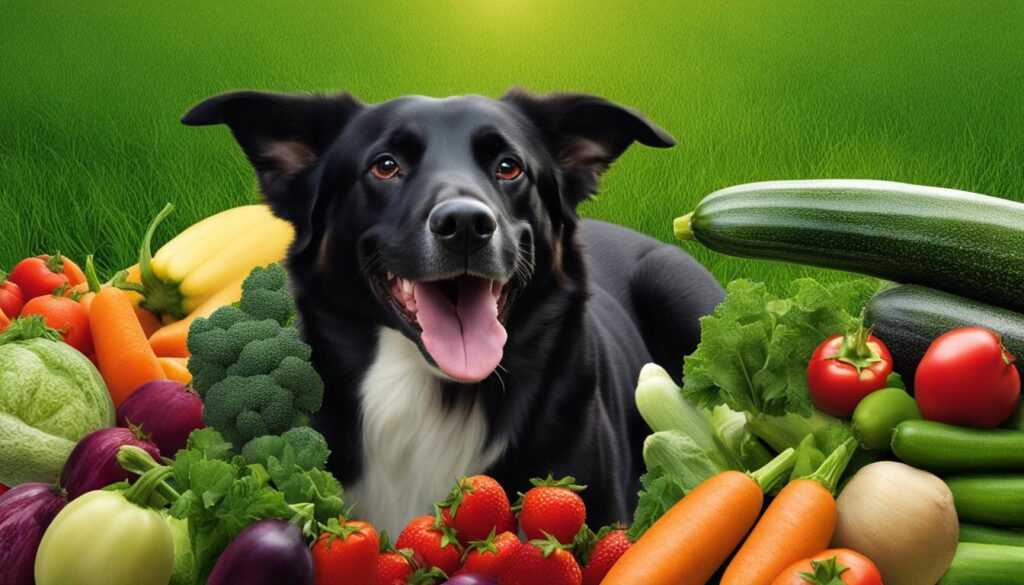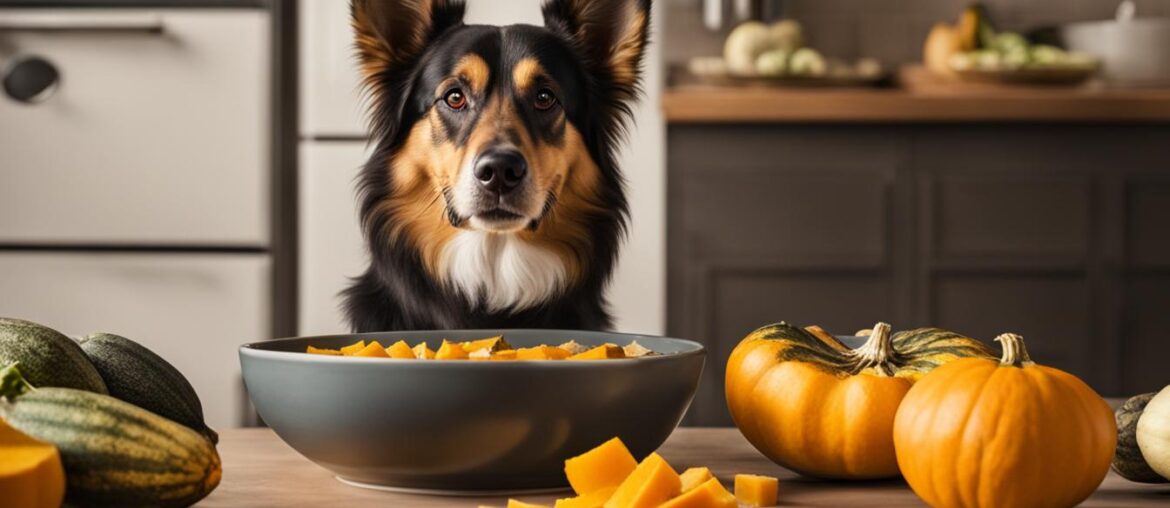Squash is a commonly enjoyed vegetable that many pet owners wonder about incorporating into their dog’s diet. If you’re curious about whether squash is safe and beneficial for dogs, you’ve come to the right place. In this article, I will provide insights into the benefits of squash for dogs and how to safely include it in their meals. So, let’s dive in and explore the world of squash in relation to our furry friends.
Key Takeaways:
- Squash is safe for dogs to eat when prepared correctly and given in moderation.
- Acorn squash, butternut squash, zucchini, pumpkin, spaghetti squash, and yellow squash are all safe options for dogs.
- Squash is rich in potassium, vitamins A and C, and fiber, providing several nutritional benefits.
- Feeding squash to dogs should involve washing, peeling if necessary, chopping into small pieces, and cooking without seasonings or extra ingredients.
- Consulting with a veterinarian is important before introducing any new foods into a dog’s diet.
The Benefits of Squash for Dogs

Squash is a nutritious addition to a dog’s diet that offers various health benefits. It is packed with essential vitamins and minerals, including potassium, vitamins A and C, and fiber, which are crucial for a dog’s overall health and well-being.
The nutritional value of squash for dogs is impressive. Potassium helps support healthy heart function and muscle strength. Vitamins A and C are essential for a strong immune system, promoting healthy skin and coat, and aiding in the absorption of other nutrients. Fiber, on the other hand, plays a vital role in maintaining healthy digestion and supporting weight management in dogs.
The high fiber content in squash can help dogs feel full while reducing calorie intake, which can be beneficial for weight management, especially for overweight or obese dogs. Additionally, the antioxidants found in squash can help reduce oxidative stress in the body, supporting overall health and reducing the risk of chronic diseases.
Adding squash to a dog’s diet can provide a tasty and nutritious way to diversify their meals. However, it is essential to prepare and serve squash correctly to ensure it is safe and beneficial for your furry friend.
- Promote healthy digestion
- Support weight management
- Boost the immune system
- Provide essential vitamins and minerals
- Reduce oxidative stress
How to Safely Feed Squash to Dogs

When incorporating squash into a dog’s diet, it is important to follow proper preparation and feeding guidelines to ensure their safety and well-being. Here are some steps to take when feeding squash to dogs:
- Thoroughly wash the squash to remove any dirt or pesticides.
- Remove any tough skin or seeds that won’t soften when cooked.
- Chop the squash flesh into small, bite-sized pieces. For spaghetti squash, use a fork to scoop out the strands.
- Cook the squash lightly without any seasonings or extra ingredients.
- Avoid dangerous ingredients like onions, garlic, and excessive salt.
- Start by incorporating a few bites of squash into your dog’s regular mealtime routine.
- Monitor your dog for any adverse reactions or digestive issues.
- Adjust the portion sizes based on your dog’s size and nutritional needs.
It is important to note that treats, including squash, should only make up approximately 10% of your dog’s daily calorie intake to maintain a balanced diet. Always consult with your veterinarian for personalized feeding recommendations for your dog.
Precautions When Feeding Squash to Dogs
While squash is generally safe for dogs, it is crucial to take certain precautions to ensure their safety:
- Avoid feeding squash to puppies, as their digestive systems are still developing and may have difficulty digesting it.
- For older dogs, consult with your veterinarian before adding squash to their diet, as they may have specific dietary requirements or restrictions.
- Monitor your dog for any adverse reactions, such as diarrhea or vomiting, which may indicate an intolerance or sensitivity to squash.
By following these guidelines and taking necessary precautions, you can safely incorporate squash into your dog’s diet and provide them with the nutritional benefits it offers.
Other Safe Foods for Dogs

Squash is not the only safe “human food” that dogs can eat. There are several other fruits and vegetables that can be added to a dog’s diet in moderation. Some examples include:
- Apples
- Blueberries
- Carrots
- Cauliflower
- Celery
- Chicken
- Cucumbers
- Green beans
- Lettuce
- Peas
- Rice
- Salmon
- Spinach
- Strawberries
- Sweet potatoes
- Tomatoes
- Watermelon
It is important to check with a veterinarian before introducing new foods to a dog’s diet, as some dogs may have sensitivities or health conditions that require specific dietary restrictions.
Note: The image above illustrates the variety of safe foods that can be added to a dog’s diet.
Feeding Squash to Puppies and Older Dogs
Puppies should not be fed squash as their digestive systems are still developing, and squash can cause constipation or bloating. It is important to prioritize their nutritional needs and provide them with food that is specifically formulated for puppies. As they grow older and their digestive systems mature, squash can be gradually introduced into their diet with the proper guidance from a veterinarian.
Older dogs, on the other hand, may have different nutritional requirements. As dogs age, their metabolism slows down, and they may require fewer carbohydrates in their diet. Before adding squash to the diet of an older dog, it is crucial to consult with a veterinarian to assess their individual needs and determine if squash is suitable for their specific dietary requirements.
Preparation and Portion Sizes
The preparation and portion sizes for puppies and older dogs should be adjusted accordingly. For puppies, it is important to focus on providing them with a balanced puppy food that meets their nutritional needs. As for older dogs, squash can be given in smaller portions to ensure it complements their overall diet without causing any digestive issues.
When preparing squash for puppies or older dogs, it should be washed thoroughly, peeled if necessary, and cooked without any seasonings or extra ingredients. The cooked squash can then be diced into small, bite-sized pieces for easier digestion. Monitoring their response to the introduction of squash is essential, and any adverse reactions or changes in their health should be discussed with a veterinarian.
Remember, every dog is unique, and their dietary needs may vary. Seeking professional guidance from a veterinarian will help ensure that the introduction of squash to a dog’s diet is done safely and effectively.
Zucchini and Dogs

Dogs can safely enjoy zucchini as part of their diet. This versatile vegetable is low in calories and high in fiber, making it a healthy addition to their meals. Zucchini is packed with essential vitamins and minerals, including vitamins A, C, and K, potassium, and magnesium, which can contribute to their overall well-being.
Feeding dogs zucchini can be done in various ways. It can be served as a fresh food topper, mixed with their regular meals, or given as a tasty and nutritious treat. Both raw and cooked zucchini are safe for dogs, but cooked zucchini tends to be easier for them to digest.
Before offering zucchini to dogs, it is important to prepare it properly. Thoroughly wash the zucchini to remove any dirt or residue. Trim off the stems and remove any seeds, as these parts can be tougher for dogs to chew and digest. Cut the zucchini into bite-sized pieces, suitable for your dog’s size.
Here are some key points to remember when feeding dogs zucchini:
- Wash the zucchini thoroughly
- Remove stems and seeds
- Dice into bite-sized pieces
- Start with small amounts
Introduce zucchini gradually into your dog’s diet, starting with small amounts. This allows you to monitor their response and ensure they tolerate it well. If your dog shows any signs of digestive discomfort or allergies, discontinue feeding zucchini and consult with your veterinarian.
“Zucchini is a healthy addition to a dog’s diet, providing them with essential vitamins, minerals, and fiber.”
Here is an image showcasing zucchini:
How to Safely Feed Zucchini to Dogs

When it comes to feeding zucchini to dogs, it’s important to do so in moderation, just like with any vegetable. Here are some guidelines to follow:
- Start by washing the zucchini thoroughly to remove any dirt or residue.
- Remove the stems and seeds of the zucchini, as these parts can be tough for dogs to digest.
- Dice the zucchini into small, bite-sized pieces that are easy for your furry friend to eat.
- Raw zucchini can be given to dogs, but cooked zucchini is easier for them to digest and reduces the risk of digestive upset.
- If you decide to cook the zucchini, make sure it is plain without any added seasonings or harmful additives.
Keep in mind that the portion size of zucchini should be adjusted based on your dog’s weight and size. It’s always best to start with small amounts and monitor your dog for any adverse reactions. Remember, every dog is unique, so it’s important to consult with your veterinarian for personalized feeding recommendations.
Adding Variety to a Dog’s Diet

Adding variety to a dog’s diet is essential to ensure they receive a wide range of nutrients and flavors. In addition to squash, such as zucchini, there are numerous other safe vegetables and fruits that can be incorporated into a dog’s meals. Diversifying a dog’s diet can provide not only nutritional benefits but also a more interesting and enjoyable eating experience for your furry friend.
When introducing new foods to a dog’s diet, it is important to follow proper preparation and portion guidelines. This helps to ensure their safety and overall well-being. By carefully diversifying their diet, you can provide a balanced combination of flavors and textures while promoting optimal health.
Benefits of Diversifying Dog’s Diet
By offering a variety of different fruits and vegetables, you can provide dogs with a wider range of essential nutrients. Each fruit and vegetable contains a unique combination of vitamins, minerals, and antioxidants that contribute to overall health and well-being. Additionally, diversifying their diet can help prevent nutrient deficiencies and promote healthy digestion.
Furthermore, adding variety to a dog’s diet can help prevent boredom and picky eating habits. Just as humans enjoy a variety of flavors and textures in their meals, dogs can also benefit from a diverse range of foods. This can make their meals more enticing and enjoyable, promoting a healthier appetite.
Safe Vegetables and Fruits for Dogs
Along with squash, there are many other vegetables and fruits that are safe for dogs to consume. Some examples include:
- Apples: Provide vitamins and fiber
- Carrots: High in beta carotene and fiber
- Cucumber: Low in calories and hydrating
- Blueberries: Packed with antioxidants
- Sweet potatoes: Rich in vitamins and fiber
- Watermelon: Refreshing and hydrating
These are just a few examples of safe options that can be added to a dog’s diet. However, it is essential to introduce new foods gradually and monitor for any adverse reactions. Every dog is unique, and what works for one may not work for another. Consulting with a veterinarian can provide personalized recommendations based on your dog’s specific needs and health considerations.
| Vegetable/Fruit | Nutritional Benefits |
|---|---|
| Squash (including zucchini) | Rich in vitamins and fiber |
| Apples | Provide vitamins and fiber |
| Carrots | High in beta carotene and fiber |
| Cucumber | Low in calories and hydrating |
| Blueberries | Packed with antioxidants |
| Sweet potatoes | Rich in vitamins and fiber |
| Watermelon | Refreshing and hydrating |
Portion Sizes and Considerations
The amount of squash a dog can safely eat depends on their size. It is important to adjust portion sizes accordingly to ensure dogs do not consume too much squash, as this can cause digestive issues. While general guidelines for portion sizes based on weight can be followed, consulting with a veterinarian for personalized recommendations is crucial. Every dog is unique, and their dietary needs may vary based on factors such as age, breed, activity level, and overall health.
When introducing squash to a dog’s diet, it is essential to monitor for any adverse reactions or changes in their health. Some dogs may have sensitivities or allergies to certain foods, including squash. If any symptoms such as vomiting, diarrhea, or excessive gas occur after consuming squash, it is important to consult with a veterinarian immediately.
To help you understand the portion sizes for dogs, below is a general guideline based on weight:
| Weight Range | Portion Size of Squash |
|---|---|
| Small Dogs (up to 20 lbs) | 1-2 tablespoons |
| Medium Dogs (20-50 lbs) | 2-4 tablespoons |
| Large Dogs (50+ lbs) | 4-6 tablespoons |
It is important to note that these are general guidelines, and individual dogs may have different needs. Some dogs may tolerate larger portions of squash, while others may need smaller portions or may not tolerate it at all. Consulting with a veterinarian will help you determine the appropriate portion sizes and frequency of feeding squash to your dog.
Potential Risks and Safety Precautions
Feeding squash to dogs is generally safe when prepared and given in moderation.
However, there are some risks and precautions to be aware of:
- Puppies: Puppies should not be fed squash due to their developing digestive systems. Squash can cause constipation or bloating in young dogs.
- Older Dogs: Older dogs may have different nutritional needs, and they may require fewer carbohydrates. It’s important to consult with a veterinarian before adding squash to their diet.
“Feeding squash to dogs is generally safe when prepared and given in moderation.”
When feeding squash to dogs:
- Cooking: Squash should be cooked plain without any added seasonings or harmful additives. Avoid ingredients like onions and garlic, which can be toxic to dogs.
- Overfeeding: Overfeeding squash can lead to digestive issues such as diarrhea or vomiting. It’s essential to portion the squash appropriately and not exceed the recommended amount.
It is important to be cautious and consult with a veterinarian before introducing squash or any new foods to a dog’s diet.
Safety Precautions When Feeding Squash to Dogs
Wrapping Up
Squash, including varieties like acorn squash, butternut squash, zucchini, pumpkin, spaghetti squash, and yellow squash, is safe for dogs to eat when prepared and given in moderation. It can provide several benefits such as weight management, digestive health, and immune support. Squash is rich in essential vitamins, minerals, and fiber. When incorporating squash into a dog’s diet, it is important to follow proper preparation and portion guidelines. Squash should be washed, peeled if necessary, chopped, and cooked without any seasonings or extra ingredients. It is essential to monitor for any adverse reactions and consult with a veterinarian for personalized recommendations.
Tips for Incorporating Squash and Zucchini Into Your Dog’s Diet
When it comes to feeding squash and zucchini to your dog, it’s important to follow some simple tips to ensure their safety and enjoyment. First and foremost, start by introducing small amounts of squash or zucchini into their diet and gradually increase the portion size over time. This allows their digestive system to adjust to the new addition without causing any upset stomach or discomfort.
As you incorporate squash or zucchini, closely monitor your dog for any adverse reactions. Keep an eye out for signs of digestive issues, such as diarrhea or vomiting. If you notice any negative effects, it’s best to consult with a veterinarian to determine if squash or zucchini is suitable for your dog and if there are any specific recommendations based on their individual needs.
When preparing squash or zucchini for your dog, it’s crucial to avoid adding any seasonings or harmful additives. Stick to plain, cooked squash or zucchini to ensure their safety. Additionally, consider adding variety to your dog’s diet by including other safe fruits and vegetables. This helps to provide a range of nutrients and flavors while avoiding reliance on a single type of food.
Always prioritize your dog’s health and consult with a veterinarian before introducing new foods to their diet. They can provide personalized recommendations and guidance on the appropriate portion sizes based on your dog’s weight and nutritional needs. By following these tips, you can safely incorporate squash and zucchini into your dog’s diet, providing them with a nutritious and enjoyable eating experience.
FAQ
Is squash safe for dogs to eat?
Yes, squash is safe for dogs to eat when prepared and given in moderation. Different types of squash, such as acorn squash, butternut squash, zucchini, pumpkin, spaghetti squash, and yellow squash, are all safe for dogs to consume.
What are the benefits of squash for dogs?
Squash is rich in potassium, vitamins A and C, and fiber. It can aid in weight loss for overweight dogs and promote healthy digestion. The nutrients found in squash can contribute to overall health, support the immune system, and reduce oxidative stress in the body.
How should I feed squash to my dog?
Squash should be washed, peeled if necessary, chopped into small pieces, and cooked without any seasonings or extra ingredients. It is important to remove any tough skin or seeds that won’t soften when cooked. Start by incorporating a few bites of squash into your dog’s regular mealtime routine and monitor for any adverse reactions.
Can dogs eat zucchini?
Yes, dogs can eat zucchini. It is low in calories and high in fiber, making it a nutritious addition to their diet. Zucchini can be fed to dogs both raw and cooked, but cooked zucchini is easier for them to digest.
How can I safely feed zucchini to my dog?
Zucchini should be washed, stems and seeds should be removed, and it should be diced into bite-sized pieces. Dogs should be started with small amounts of zucchini to ensure they tolerate it well. Cooked zucchini is recommended as it reduces the risk of digestive upset.
What other safe foods can I add to my dog’s diet?
Along with squash, other safe fruits and vegetables that can be added to a dog’s diet in moderation include apples, blueberries, carrots, cauliflower, celery, chicken, cucumbers, green beans, lettuce, peas, rice, salmon, spinach, strawberries, sweet potatoes, tomatoes, and watermelon.
Can I feed squash to puppies and older dogs?
Puppies should not be fed squash as their digestive systems are still developing, and it can cause constipation or bloating. Older dogs may have different nutritional needs and may require fewer carbohydrates, so it is important to consult with a veterinarian before adding squash to their diet.
How much squash can dogs eat?
The amount of squash a dog can safely eat depends on their size. Portion sizes should be adjusted accordingly to ensure dogs do not consume too much squash, which can cause digestive issues. Consult with a veterinarian for personalized recommendations.
Are there any risks or precautions when feeding squash to dogs?
Feeding squash to dogs is generally safe when prepared and given in moderation. However, there are some risks and precautions to be aware of. It is important to avoid dangerous ingredients like onions, garlic, and excessive salt. Overfeeding squash can lead to digestive issues. Consult with a veterinarian before introducing squash or any new foods to your dog’s diet.
What are some tips for incorporating squash and zucchini into my dog’s diet?
Start with small amounts and gradually increase the portion size. Monitor for any adverse reactions and consult with a veterinarian for personalized recommendations. Always feed dogs plain, cooked squash or zucchini without any seasonings or harmful additives. Variety can be added to a dog’s diet by including other safe fruits and vegetables.
How do I determine the portion sizes for my dog?
The portion size of squash should be adjusted based on the dog’s weight. Guidelines for portion sizes can be followed, but it is important to consult with a veterinarian for personalized recommendations. Monitor for any adverse reactions or changes in your dog’s health when introducing new foods.
What is the conclusion regarding feeding squash to dogs?
Squash is a safe and nutritious addition to a dog’s diet when prepared and given in moderation. It can provide several health benefits such as weight management, digestive health, and immune support. Follow proper preparation and feeding guidelines, consult with a veterinarian for personalized recommendations, and monitor for any adverse reactions.
What are some tips for safely feeding zucchini to dogs?
Thoroughly wash the zucchini, remove stems and seeds, and dice it into bite-sized pieces. Start with small amounts and monitor for any adverse reactions. Cooked zucchini is easier for dogs to digest. Always feed zucchini plain without any added seasonings or harmful additives.






